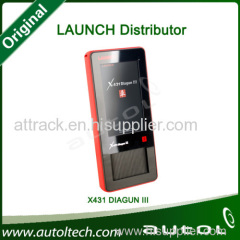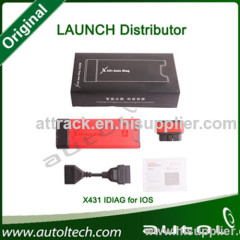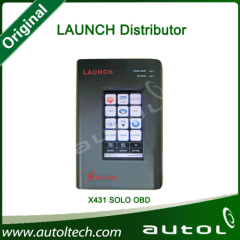|
Sherry-Autol Technology Co., Limited
|
New Released Launch Creader V Plus Original Update Via Network
| Place of Origin: | Guangdong, China (Mainland) |
|
|
|
| Add to My Favorites | |
| HiSupplier Escrow |
Product Detail
LAUNCH Creader V+ is the next generation of vehicle fault diagnosis tool developed by
Launch, especially for the DIY users and the servicemen of sm
Skype: autolsale008
Email: sherry@autoltech.com
Website:http://www.autoltech.com/
2014 New Release LAUNCH Creader V+ DIY Code Reader
LAUNCH Creader V+ is the next generation of vehicle fault diagnosis tool developed by
Launch, especially for the DIY users and the servicemen of small service
workshop. It supports read/clear DTCs and read datastream. With built-in help
menus and code definitions, diagnosing and repairing that dreaded Check
Engine Light is now easier than ever!
Moreover, Creader V+ also feature the following bi-directional "special tests":
EVAP, O2 Sensor, I/M Readiness, MIL Status, VIN Info, and On-board monitors
testing.
Creader V + Highlights:
1. Support Color, the Multiple Graphics Streams
2. Multi-Language Supported: English, French, Spanish
3. Support Fault Code Query
4. Update: Software Upgrade via USB port network Quick upgrade via USB 2.0
Advantage of LAUNCH Creader V+:
Support Agreement: ISO9141-2, ISO14230-4, SAEJ1850, ISO15765-4
Support Mode $ 01 reading dynamic data flow, fault indicator light, ready state
Support Mode $ 02 freeze frame data query
Support Mode $ 03 reading current fault codes
Support Mode $ 04 clear fault codes
Support Mode $ 05 oxygen sensor detection test
Support Mode $ 06 monitor specific vehicle monitoring system
Support Mode $ 07 pending fault code reading
Support Mode $ 08 monitor vehicle systems or components
Support Mode $ 09 to read vehicle information
Support Mode $ 0A permanent fault code readingfeatures:Full support OBDII functions
Data Flow graphics capabilities, allowing more intuitive observation
Have trouble code, data stream and other information queries
Silicone keys, 6 key operation more comfortable and convenient
It can be connected to PC through the USB cable for upgrade to keep updated
with the latest software version.
Notice: Creader V+ may automatically reset while being disturbed by strong
static electricity. THIS IS A NORMAL REACTION.
Support Multi-Language:English,French,Spanish
Diagnostic Trouble Codes (DTCs)
OBD II Diagnostic Trouble Codes are codes that are stored by the on-board
computer diagnostic system in response to a problem found in the vehicle.
These codes identify a particular problem area and are intended to provide you
with a guide as to where a fault might be occurring within a vehicle. OBD II
Diagnostic Trouble Codes consist of a five-digit alphanumeric code. The first
character, a letter, identifies which control system sets the code. The second
character, a number, 0-3; other three characters, a hex character, 0-9 or A-F
provide additional information on where the DTC originated and the operating
conditions that caused it to set. Here below is an example to illustrate the
structure of the digits
Specifications
Screen 2.4" TFT, 176*220 dots LCD display
Input voltage range 9 ~ 18V
Operating temperature 32°F~122°F / 0°C~50°C
Storage tempetature -4°F~158°F / -20°C ~70°C @ RH60%
Outline dimension 120*75*20 mm (L x W x H)
Weight <17.6 oz (500g)
Accessories
1) User's Manual -- Instructions on tool operations
2) USB cable -- Connect to a computer for upgrading online
Power supply
The power of the Creader V+ is provided via the vehicle Data Link Connector
(DLC). Follow the steps below to power it up:
1) Find DLC on vehicle
A plastic DLC cover may be found for some vehicles and you need to
remove it before plugging the OBDII cable.
2) Plug the connector at the end of OBD II cable to the vehicle's DLC.
Vehicle Coverage
The Creader V+ is specially designed to work with all OBD II compliant vehicles,
including Control Area Network (CAN). It is required by EPA that all 1996 and
newer vehicles (cars and light trucks) sold in the United States must be OBD II
compliant and this includes all American, Asian and European vehicles.
A small number of 1994 and 1995 model year gasoline vehicles are OBD II
compliant. To verify if a 1994 or 1995 vehicle is OBD II compliant, check the
Vehicle Emissions Control Information (VECI) Label, which is located under the
hood or by the radiator of most vehicles. If the vehicle is OBD II compliant, the
label will designate "OBD II Certified". Additionally, Government regulations
mandate that all OBD II compliant vehicles must have a "common" sixteen-pin
Data Link Connector (DLC).
For the vehicle to be OBD II compliant it must have a 16-pin DLC (Data Link
Connector) under the dash and the Vehicle Emission Control Information Label
must state that the vehicle is OBD II compliant.
Online Upgrading
Log on to www.crecorder.com, download the latest version of the Creader V+
upgrade package, and then decompress the software to local disk. Click it to run
and install it until it is complete.
Connect the Creader V+ to computer through USB cable and run the Creader
V+ Upgrade.exe, a screen similar to the following figure will appear:
Select the language, and then click "Start Upgrade" when a message of
upgrading succeed pops up, click" Exit", unplug USB cable to complete upgrade.
Operations:
1.Connection
1) Turn the ignition off.
2) Locate the vehicle's 16-pin Data Link Connector (DLC).
3) Plug the OBDII cable into the vehicle's DLC.
4) Turn the ignition on. Engine can be off or running.
main menu
CAUTION: Don't connect or disconnect any test equipment with ignition on
or engine running.
2.Diagnose
diagnose
diagnose2
3.Read Codes
read codes
read codes2
read codes3
4.Erase Codes
Erase codes
Erase codes2
Erase codes3
Package List:
1pc x LAUNCH Creader V+
FAQ:
Here we list some frequently asked questions and answers relating to Creader
V+.
Question: System halts when reading data stream. What is the reason?
Answer: It may be caused by a slackened connector. Please turn off the
Creader V+, firmly connect the connector, and switch on it again.
Question: Screen of main unit flashes at engine ignition start.
Answer: Caused by electromagnetic disturbance and this is normal
phenomenon.
Question: There is no response when communicating with on-board computer.
Answer: Please confirm the proper voltage of power supply and check if the
throttle has been closed, the transmission is in the neutral position, and the
water is in proper temperature.
Question: Why are there so many fault codes?
Answer: Usually, it's caused by poor connection or fault circuit grounding.


























